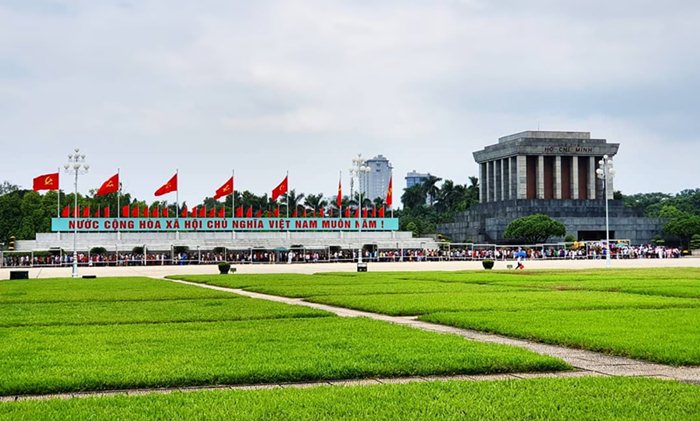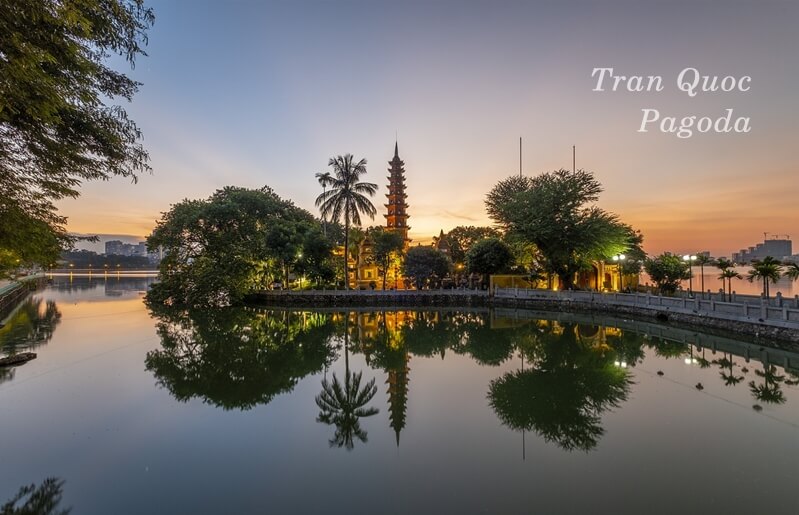Ba Dinh Square, Vietnam’s largest square, is also the place to record many important marks in Vietnamese history.
Right in the square on September 2, 1945, President Ho Chi Minh read the Declaration of Independence that gave birth to the Socialist Republic of Vietnam. So, that is why this place is also known as the heart of the capital.

Hanoi Unveiled Full-Day City Tour to Explore Top Attractions
Ba Dinh Square in Hanoi
Ba Dinh Square situates on Hung Vuong Street, Hanoi, and right in front of Ho Chi Minh’s mausoleum. This site is also the western gate area of the old Thang Long citadel.
- Address: Hung Vuong Street, Ba Dinh District, Hanoi, Vietnam
- Opening hours: 5:00 am – 10:00 pm
1. History of Ba Dinh Square
Previously, the square area was located in the complex of Thang Long citadel, until 1808 when the Gia Long Dynasty demolished it. But, immediately after that, a much smaller one was rebuilt.
In 1831, King Minh Mang renamed this place Hanoi.
At the beginning of the 20th century, the French colonialists demolished the old citadel to make a square, then named a French priest Puginier or also known as the Puginier round point.
After two times of the name changed to Hong Bang Square and Independence Square, it was renamed Ba Dinh Square in 1945.
Over the years, Ba Dinh Square seems to have become a silent witness to historical periods through the ups and downs of Vietnam.
2. The historical landmarks in Ba Dinh Square
Ba Dinh Square carries vital historical meanings for many generations of Vietnamese people on September 2, 1945.
At 14 o’clock on September 2, 1945, plenty of people in Hanoi and surrounding areas are excited to listen to the declaration of independence that gave birth to Vietnam.
The period from 1954 to 1969 is near this place where Uncle Ho lived and worked. At the same time, the square had held significant meetings in Vietnam.
On October 10, 2010, a large-scale ceremony took in the square on the occasion of the 1,000 year anniversary of Thang Long – Hanoi.
3. The essential buildings in Ba Dinh Square
Ba Dinh Square is a unique architectural complex. Through many times with historical ups and downs as well as the changes, Ba Dinh has got the beautiful architecture.
In Central Square are other architectural works such as:
- Ba Dinh hall finished in 1963
- Ho Chi Minh Mausoleum, completed in 1975 and built right at the position of the person who read the Declaration of Independence in 1945
- Ho Chi Minh Museum, built in 1990
- Monument to heroes and martyrs who died in the resistance wars to defend the homeland, constructed in 1994
Right next to the Ba Dinh Square area are the relic complex of Presidential Palace and One Pillar Pagoda. All are unique architectural works bearing the historical and humanistic significance of the nation through the stages of development.
4. Explore Ba Dinh Square
Today, when coming to Ba Dinh Square, we will see the highlight that is mausoleum of Ho Chi Minh. In front of the mausoleum is a large square campus with a length of 320m and a width of 100m, accommodating up to 20,000 people.
There are 210 green grass squares, between the grass fields is a 1.4m wide walkway. Right in the middle of the square is the 30m high flagpole. This place becomes a sacred space of Hanoi capital, especially on Independence holidays.
Ba Dinh Square has become a close and sacred name and also a national pride with historical imprints that never fade.
The major events and great celebrations of the nation are often organized at this site.
Ba Dinh Square is the national pride and meaningful historical place to visit, attracting a lot of domestic and international tourists.
In particular, every day, there will be a flag-raising ceremony (6:00 am in summer and 6:30 pm in winter) and a flag-lowering ceremony (9:00 pm) solemnly held at Ba Dinh Square, which the guests can see when coming to Ba Dinh Square.
5. Frequently asked questions about Ba Dinh Square
5.1. Do I need to buy a ticket to visit Ba Dinh Square?
No, you do not. Ba Dinh Square is an opening-space, so this destination is free for visiting.
5.2. When is the best time to visit Ba Dinh Square?
The best time to visit Ba Dinh Square is in the morning because you will have a chance to explore the surrounding attractions, such as One Pillar Pagoda or Ho Chi Minh Museum.
If you want to see the flag-raising or flag-lowering ceremony, you need to come here in the early morning at 6:00 am or 9:00 pm.
5.3. Do we need to book a tour to visit Ba Dinh Square?
A city tour often includes Ba Dinh Square. So, please check your one-day itinerary if it covers Ba Dinh Square. If yes, that is so good. If not, you can come to visit this place by yourself.
5.4. How long can we visit Ba Dinh Square?
If visiting Ba Dinh Square and taking pictures, it takes you only around 30 minutes. However, if you also explore most attractions around Ba Dinh Square and Ho Chi Minh Mosauleum, it may take you around 2.5 hours.
5.5. Who named Ba Dinh Square?
One unique thing is that the name Ba Dinh Square was given by Dr. Tran Van Lai, former leader of Hanoi, rather than Uncle Ho as many people think.
